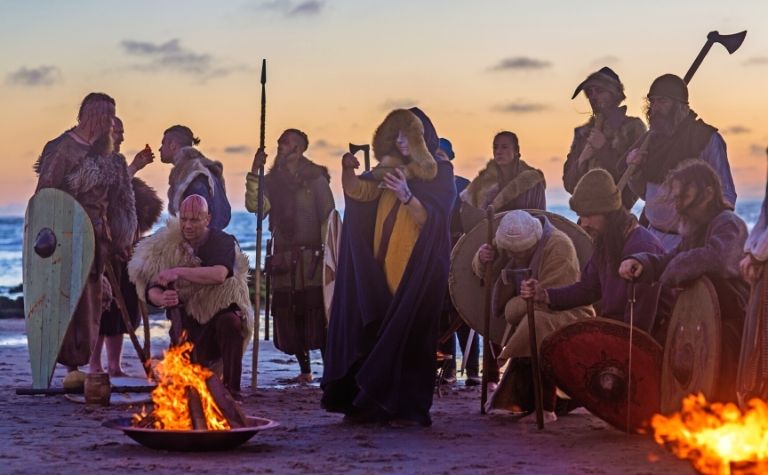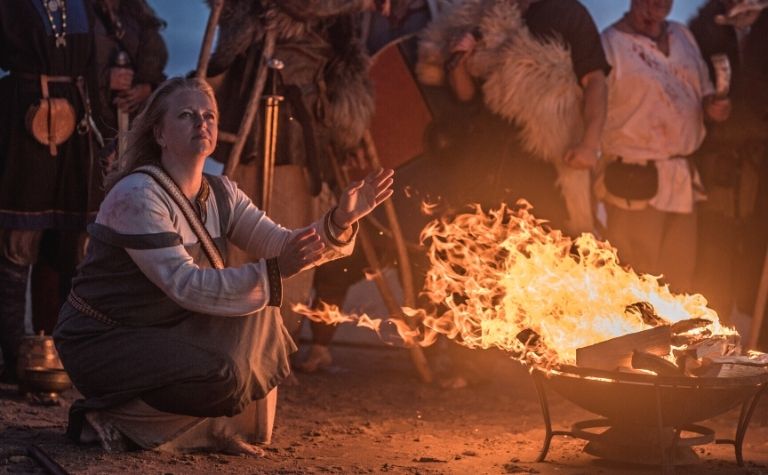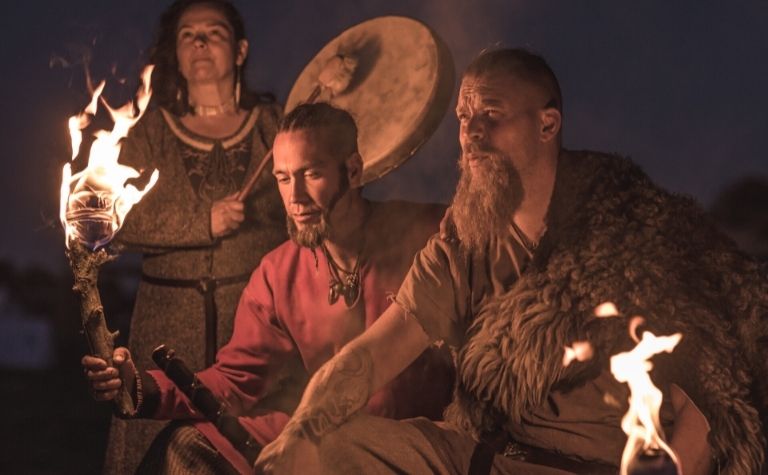While the predominant image of the Vikings today is as fierce warriors and fearless voyagers, Norse culture also had other distinguishing features to recommend it.
The Norse produced exquisite decorative arts, fantastic sagas, and epic feasts. How then would they have celebrated Birthdays?
Vikings did not celebrate birthdays annually. They did celebrate births, marriages, and other significant events in an individual’s life.
However, there is no evidence that Vikings marked the passing of a year in an individual’s life with a celebration in the way that it is now practiced.
The rest of this article will look at Viking celebrations in greater detail, explaining the kinds of events the Norse culture celebrated and how they did so.
Also see Traditional Female Viking Hairstyles to learn more.

How Did the Vikings Say Happy Birthday?
Vikings said happy birthday by wishing someone sæll burðardagr, or at least they would have if they celebrated birthdays annually.
Since they did not celebrate annual birthdays, there is no evidence that Vikings actually wished each other sæll burðardagr.
Sæll means happy in old Norse. Burðardagr is a composite word derived from burðr, meaning birth, and dagr, which means day. [1]
So, were a Viking to wish someone happy birthday, they might have said sæll burðardagr.
However, that Vikings actually said sæll burðardagr is highly unlikely.
While the Vikings did celebrate events such as births, marriages, and other significant events in an individual’s life, they aren’t known to have celebrated birthdays annually.
Since Norse culture was primarily oral, most of the surviving texts on Vikings are written by foreigners, often centuries later.
This means that there is limited information available on the minutiae of Viking life.
In this context, deciphering how Vikings would have said happy birthday is a highly speculative endeavor.
Moreover, even in the English language, the phrase happy birthday is of relatively recent origin. [2]
Until the 19th century, most people would have wished each other happy returns on birthdays to mark the return of the date of birth.
Also see Were the Vikings Celtic? to learn more.

What Did Vikings Do for Their Birthdays?
What Vikings did for their birthdays is not known. There is no evidence they celebrated birthdays annually.
They did, however, celebrate the births of children with prayers, songs, and a naming ceremony nine days after the birth of the child.
In the 9th and 10th centuries A.D., when most Vikings lived, the infant mortality rate was extremely high.
The survival of a child at birth and into adulthood was not taken for granted.
Because of this, births were notable occasions, both tense and worth celebrating.
Before births, Vikings prayed to Freya, the Norse goddess of love and fertility.
They also sang ritual songs for the good health of the mother and child.
When a baby had survived nine days, a naming ceremony was held for the child.
The father would place the infant on his knee, and water would be sprinkled on the child.
Afterward, gifts were presented by guests.
The naming ceremony served to induct Viking children into their new clans.
It also had significance according to Norse law, as the child was now protected by the appropriate legal rights.
Before this occasion, the child had no such rights and was not officially a member of the clan.
Also see Vikings vs German Barbarians: Comparison to learn more.

What Celebrations Did Vikings Have?
Vikings had celebrations for various occasions, including:
- Marking the passing of seasons
- Harvest festivals
- Religious rituals
- Commemorating the accomplishments of the clan
- Remembrances for famous ancestors and pinnacles of society
- Milestones in the lives of individual members of the clan
The Vikings had their own calendar, with 12 months of 30 days each and an added four days every fourth year to account for leap years. [3]
As the passing of the seasons is particularly pronounced in the Northern regions they lived in, equinoxes and solstices were significant occasions in the Norse calendar.
Some of these events are celebrated in modified forms even today.
The spring equinox festival Ostara bears some resemblance to today’s Easter, and the winter solstice festival Yule would later morph into the Christian Christmas. [4]
Vikings also held feasts to honor the many Norse gods and goddesses.
These occasions would be marked by prayers and animal sacrifices to gain the favor of the gods.
This was a pure quid pro quo, with the Norse sacrificing animals to the god in expectation of good weather or a bountiful harvest.
Often, Viking celebrations combined several of these aspects into one series of events.
The festival of Alfarblót, for instance, marked both the first day of winter and the last harvest of the year, as well as a celebration of the fertility goddess Freya.
Apart from these fixed events in the calendar, the Norse also celebrated momentous events like a successful raid by a traveling Viking party once they returned.
They held remembrances for famous ancestors and days of celebration for husbands and wives.
Vikings also celebrated significant events in the lives of individual clan members, such as births and marriages.
Also see Are the Finnish People Vikings? to learn more.
What Were Viking Celebrations Like?
Viking celebrations were whole days of festivities in which the entire community participated.
The events were marked by feasting and drinking, boisterous games, singing, prayers, and blood sacrifices.
Many of the Vikings’ celebrations were held over extended periods running into several days at a time.
Celebrations for Yule, the winter solstice festival, are thought to have run on for almost two whole weeks.
Viking festivals were celebrated in giant communal gathering places known as mead halls.
Archaeological digs have found mead halls 50 meters (54.68 yards) long.
Because they were so large, mead halls were usually owned by and located on the lands of the richest Viking lords.
The festivals also involved the consumption of copious amounts of meat and alcohol. Poultry, beef, and horse were some of the Vikings’ favorite foods.
These were accompanied by beer, ales, meads, and wines.
While religious events were accompanied by prayers and blood sacrifices, the festivals also made room for more light-hearted pleasures.
These included songs, poetry, and games of strength that could be particularly violent and even fatal.
Conclusion
Although Vikings did not celebrate birthdays, they did enjoy many other festivities throughout the year.
These were boisterous events in which the whole community participated.
Also see Are the Scottish Descendants of the Vikings? to learn more.
